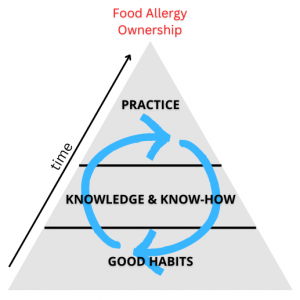One of our jobs as food allergy parents is to gradually hand off the responsibility for managing food allergies to our kids who have to live with them day in and day out. It can be a bit of an anxiety-provoking process, since missteps can have serious consequences and missteps will happen.
But, please hold onto the following thought if you take nothing else away from this article…
Long term, you will launch your kids with food allergies into adulthood and they will be equipped to be OK because you will have prepared them — over the years — to take charge of their food allergies, to fully own** them.
The hand off process is gradual and is undertaken in age appropriate ways, until they become young adults. The process involves:
- Forming good food allergy habits,
- Teaching them about their food allergy diagnosis (i.e., transferring the knowledge) and everything they need to do (i.e., embedding the know-how) to stay safe, and then
- Giving them the chance to practice key skills when they’re ready like carrying their own epinephrine, label reading, self-advocating with peers & adults, researching events, knowing how to handle an allergic reaction, and knowing how to fill an epinephrine prescription in a continuous ‘wash-rinse-repeat’ cycle.
It looks something like this:

Forming good food allergy habits is a foundational piece of the process.
You can begin encouraging the development of good habits from the earliest days of your family’s food allergy diagnosis.
Forming Good Habits—start with baby steps
Habits are the brain’s way of optimizing for efficiency. Once formed, they’re virtually on auto-pilot (like brushing teeth, or tying shoelaces, or looking both ways to cross a street.) In contrast, routines are deliberately practiced (like doing homework right after school, or reading a story before bedtime, or doing Saturday chores.) While both are regular, repeated actions routines require intention and effort, and habits are seamlessly integrated into our days without much thought or energy expended.
Habits can be systematically formed. They can be good or bad. They can be broken and discarded. Routines can become habits over time.
For good habits to stick it’s helpful to stack or add them onto something you do already — you start small, do them every day, make them easy to do, and you celebrate successes. Behavioral scientist BJ Fogg, PhD, who founded the Behavior Design Lab at Stanford University and wrote “Tiny Habits: The Small Changes That Change Everything,” innovated the ideas that underlie the concept of habit stacking. To dive deeper and learn more about the power of habits and of stacking them, check-out the resources at the end of this post.
Forming Good Food Allergy Habits—building them into your lifestyle
Aspects of allergic living are ripe for becoming habits when you start encouraging them early.
For example, slip on some allergy ID jewelry — a bracelet or a necklace — when you dress your child for the day, or help them dress themselves. The allergy ID jewelry becomes just another part of their daily outfit, a habitual part of the getting dressed process — shirt, pants, socks, shoes…allergy ID jewelry. In time, wearing it will become a habit and it will feel like something’s missing if they forget to put it on.
It’s far easier to start forming the habit to wear allergy ID jewelry when your child starts preschool, than trying to introduce it when they start middle or high school.
The timing for forming different allergy management habits will vary, but it all begins by enabling and modeling the skills you want your child to form.
The idea of ‘enabling’ used here means you have the right resources and accessories on hand at home to support the habit you’re trying to develop. And ‘modelling’ here means you show by doing, leading by example every time, even when time (and/or your patience) is short.
Think about the need to keep epinephrine within reach at all times to be prepared for an allergic reaction that may or may not [ever] happen.
What habits can you create to keep epinephrine within reach at all times?
ENABLING
- Having your child choose a medication or ‘epi bag’ in a style and fun color they like.
- Having your child help you pack the epi bag when using it for the first time, talking through each and every thing you put in the bag, from the antihistamine, to the autoinjectors x 2, to their Emergency Action Plan, to an inhaler and their spacer.
- Creating a secure at home place for the epi-bag (with your child if they are a little older) — where it always lives when you’re home. For example, keeping the epi-bag on a hook by the door you use to leave home so you and your child are physically reminded to take it each time you leave.
- Designating an on-the-go home for the epi bag — where it always lives when you’re out and about, e.g., your purse, the snack bag, their backpack (depending on their age), the family backpack.
- Upgrading the epi-bag to something more convenient and discrete to self-carry as your child gets older and grows more independent like a SPIbelt.
MODELLING
- Doing an epi bag check-in each and every time you’re about to leave home, starting by asking your child, “Do we have our epi-bag?”
- Grabbing the epi-bag and placing it in its on-the-go home as you leave home, each and every time you leave, including your child in the act, whether passive as an observer or active as a participant.
- Replacing the epi-bag on it’s special hook by the door each time you return home, including your child in the act, whether passive as an observer or active as a participant..
- If you ever leave home without the epi-bag, making it a BIG DEAL to turn around and retrieve it when it’s MIA, even if you’re running late.
Children are naturally curious with great powers of observation. Sometimes you don’t think they are watching (and learning) but they are. American writer James Baldwin once said, “Children have never been very good at listening to their elders, but they have never failed to imitate them.” Be the example you want them to be, in all things big and small.
Examples of some other ‘survival’ skills with potential to become good food allergy habits are:
- Reading food labels before buying any packaged food, even foods purchased before.
- Always carrying an extra safe snack (or two).
- Bringing safe food to every playdate, every party, every gathering.
- Explaining food allergies at restaurants to servers and chefs each and every time you dine out.
It’s said that the journey of a thousand steps begins with the first step. And so it is with handing over food allergy responsibility** to your child so they’re prepared to live fully and safely when they grow up. Starting to intentionally develop good food allergy habits as soon as you get the diagnosis is a right-sized first step towards achieving this [very] long-term goal.
As a food allergy parent you always want to be in food allergy hand-off mode with your child, with one eye on today, and one eye on the future.
Go slowly. Go gently. Over the years. As they grow
“Drop by drop is the water pot filled.”
—Buddha
 |
Empowering people to live more easily & safely with food allergies through technology and education. |
| About the Author: Gayle Rigione is CEO of Allergy Force, the food allergy management app. She’s also an allergy mom. She’s lived the heart stopping moments when her son ate the wrong thing, second guessed reactions and spent the night in the ER. Her professional and personal experiences fuel her passion for creating tools for people with food allergies. Whatever you do, do it with a full heart. Audentes Fortuna Iuvat | |
Images: Courtesy of Allergy Force and Iiona Virgin on Unsplash
Resources
FORMING GOOD HABITS
- TedxFremont talk by BJ Fogg: “Forget big change, start with a tiny habit”
- Article by Elizabeth Dougherty (McGovern Institute for Brain Research) for MIT News: Wired for habit
- Article by Erin Eatough, PhD for www.betterup.com: Building good habits in your life (and ditching bad ones)
- Article by James Clear—Bestselling Author, Speaker: How To Start New Habits That Actually Stick
- Article by James Clear: How to Build a New Habit: This is Your Strategy Guide
- Post by Seth Godin—Bestselling Author, Entrepreneur, Speaker: Make a habit/break a habit
** ‘FULL OWNERSHIP’ OF FOOD ALLERGIES DEFINED
‘Full Ownership’ of food allergies means that your child — as an older teen, young adult — has the knowledge and know-how to live fully and safely when you’re not there. It means your child has mastered specific allergy lifestyle planning, analyzing, communicating, and technical skills. They:
- Know what all their allergens are plus the alternative names for their allergens that might appear on food labels.
- Know what the telltale signs of an allergic reaction are, whether they’ve personally experienced all of the symptoms, or not.
- Know to tell someone when they’re experiencing symptoms and ask for the help they need.
- Know how and when to use their auto-injector, and when to use their second auto-injector.
- Manage their epinephrine auto-injectors 100%, from self-carrying them, to protecting them from extremes of heat or cold, to tracking expirations dates, to renewing the prescriptions when they expire.
- Know how to read and evaluate food labels (including the voluntary precautionary allergen labeling,) when to call manufacturers with questions, and what questions to ask to evaluate whether a food is safe for them to eat. Or not.
- Understand cross contact and how and where it can happen.
- Are generally familiar with food preparation & serving processes in commercial kitchens, as well as which cuisines might be particularly risky for them to eat.
- Self-advocate with confidence, explaining their allergies and safety requirements to others, like restaurant staff, food service employees, coaches, teachers, roommates, camp counselors, new friends.)
- Have go-to strategies they use to stay safe when they’re out and about or socializing.
- Have begun to drive their allergist/immunologist relationships, for example scheduling their own appointments and OK-ing testing/treatment plans.


